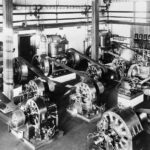What is rewinding an electric motor?
Electric motor rewinding is a winding technique that tries to increase the efficiency of motors that have seen their efficiency deteriorates.
Electric motor rewinding generally involves a few steps: removal or stripping of the winding (coils), Inserting and connecting new winding (coils), and insulating the complete winding.
How can you know whether your electric motor has to be rewound?
Exclude obvious causes
To figure out if your motor needs to be rewound, start by eliminating any obvious culprits. Begin by evaluating the condition of your motor and making a note of any physical flaws. Broken mounts, burn scars, and contamination from water or rust are all obvious issues. Try spinning the shaft by hand after you’ve completed a preliminary inspection of the component.
If you can’t move the fan, it could be due to an obstruction or failing bearings, rather than a winding problem.
Testing Motor windings
Measure winding resistance, verify 3 phase windings by providing low voltage and make sure the currents are balanced once you’ve confirmed that the motor isn’t failing due to an evident mechanical reason.
Measuring IR
Insulation resistance (IR) is a metric that can be used to detect whether or not your motor needs to be rewound. These measurements can be made between the windings as well as between the windings and the earth point. The Insulation resistance value should be at least 2M ohms and preferably larger than 100M ohms.
A reading of less than 2M ohms shows that the insulation is failing or has already failed. Low IR is responsible for a large number of winding defects. Low IR can be caused by contamination, power surges, extreme heat, vibration, or damaged wires. A thoroughly clean and dry may assist to resolve these issues in some circumstances, but an electric motor rewind is frequently the most effective way to restore optimal performance.
Why Should You Rewind Your Motor?
If your electric motor needs to be rewound, it’s because the coils have been shorted, grounded, or otherwise damaged. Motor failures that cause motors to need to be rewound can be caused by a variety of problems, most of which manifest themselves as failing insulation and/or grounded/shorted coils.
Windings with shorted turn-to-turn or phase-to-phase, coil-to-coil, or grounding at the slot’s edge are all examples of insulation failures. Contamination, abrasion, voltage surges, the machine’s general age, or vibration are the most common causes of these problems.
Motor insulation failures are very frequently caused by thermal degradation. It occurs when the insulation overheats as a result of inadequate connections in the motor terminal, a locked rotor causing high currents in the stator, excessive load demands exceeding the motor’s rating, or excessive reversals and starts.
Is rewinding a motor worth it?
Is your motor beginning to exhibit symptoms of wear and tear? Have you ever looked into acquiring a new motor and been surprised by the price? Perhaps you should have your old motor rewound. The expense of having your motor rewound is just around 40% of the cost of buying a new motor. Rewinding your motor not only saves money but also helps the environment. When compared to the carbon costs of producing a brand new motor, the rewind process has a negligible environmental impact.
When to Rewind and When to Replace?
Signs that it’s time to REWIND:
- Burns, damaged pieces, dampness, and rust are all indicators of degradation.
- The laminations have not been harmed.
- Winding resistance is reduced. (This indicates that the motor’s coils are shorted.)
- Insulation resistance issues are a problem.
- Your engine is between 12 and 15 years old.
Symptoms that you should REPLACE:
- The magnetic core isn’t in great shape.
- Your engine is over a decade old.
- Before this rewind, your motor had been improperly rewound.
- Your engine has been irreversibly damaged.
- Bearing failure has caused the armature to grind against the stator, resulting in irreversible damage.
When determining whether to rewind or replace your motor, keep in mind the potential savings from replacing your old motor with a much more energy-efficient one.
What Does It Take to Rewind an Electric Motor?
The removal or stripping of the winding, the insertion and connection of fresh winding, and the insulation of the entire winding are the three essential steps in rewinding an electric motor. However, the rewinding procedure is not always as straightforward as it appears.
Data Collection for Winding
Even if the motors have the same horsepower, speed, and voltage, a technician will need to collect winding data because most motors have considerable variances in their windings. The number of slots, wire size, number of coils, number of turns per coil, essential dimensions, bracing, and insulation characteristics are all included in this data. This information is used to duplicate the original motor and to suggest design adjustments that will increase performance and lengthen the meantime to failure.
This information should be compared to the EASA Winding Data Verification programme or other applicable programmes to ensure that the winding arrangement meets or exceeds the motor’s nameplate data and performance.
This is a crucial step since someone may have previously rewound the motor incorrectly, and if you don’t double-check the data, you risk repeating the previous repair shop’s error. This can be avoided by double-checking the data.
Stripping and Burnout
The existing motor windings are taken out of the motor core once all of the important data has been acquired. This is accomplished by placing the motor’s stator in a high-temperature oven known as a burnout or burnoff oven.
To prevent the motor from overheating and damaging the core insulation, ensure the oven is monitoring oven and part temperatures. A moisture suppression system should also be installed in the oven to avoid the temperature from rising too high. For larger units, this burnout stage might take several days and results in the insulation being burned to ash. After it has cooled down, the windings are physically removed from the stator core, a process known as stripping. The majority of the time, you’ll be collecting winding data during the stripping procedure.
To ensure the authenticity of the core iron insulation, a core-loss test should be done both before and after the oven operation.
Creating Coils
After that, the coils are made. Placement, wire tension, and keeping track of the number of turns on the coil are all important aspects of this operation. Keep in mind that the technique differs depending on whether you’re making random wound coils or form wound coils. In a repair shop, random wound coils are made utilizing buckets of magnet wire and winding heads to create the desired length coil. Form coils are manufactured by a company that specializes in them and has the necessary wire, tapes, press equipment, spreading equipment, and testing capabilities, among other things.
Connecting and inserting the windings
The coils are then joined after being put in the stator slots. The process of adding coils differs depending on whether you’re working on a random wrapped winding or a form coil winding, but the basic process of inserting coils and insulation into the core of the motor remains the same. The coils must then be connected to produce the complete winding. The winding’s blocking and bracing is essential consideration in this process. Mechanical movement causes winding failure if a winding is not properly supported.
Testing coil Windings
Throughout the rewinding process, multiple tests are performed to assure the accuracy and reliability of the coil windings. These tests are carried out according to IEEE and EASA guidelines. After the rewinding process is finished, the insulating procedure begins.
ElectricmotorshopJobs.com keywords: electric motor rewinder jobs, electric motor technician jobs, electric motor jobs, rotor winding jobs, stator winding jobs, lap winding jobs, electric motor rewinding jobs, electric motor rewinding, electric motor shop jobs


